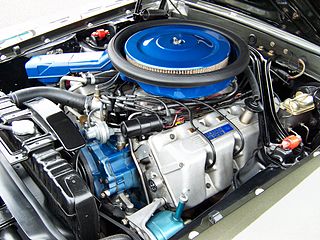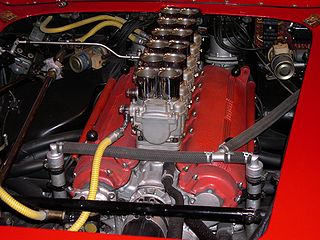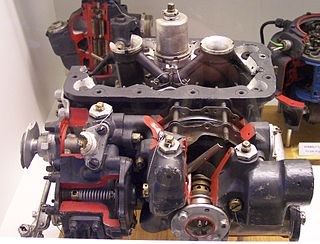
A carburetor is a device used by a gasoline internal combustion engine to control and mix air and fuel entering the engine. Carburetors can be quite complex but the primary method of adding fuel to the intake air in the main metering circuit is through the pressure difference using the Venturi effect from two separate holes in the air flow or from Bernoulli's principle at the fuel orifice and ambient air pressure from a vent for the fuel bowl or the Pitot pressure at the air entry into the carburetor.

The Ford FE engine is a medium block V8 engine produced in multiple displacements over two generations by the Ford Motor Company and used in vehicles sold in the North American market between 1958 and 1976. The FE, derived from 'Ford-Edsel', was introduced just four years into the short-lived Ford Y-block engine, which American cars and trucks were outgrowing. It was designed with room to be significantly expanded, and manufactured both as a top-oiler and side-oiler, and in displacements between 332 cu in (5.4 L) and 428 cu in (7.0 L).

The Ford 385 engine family is a series of "big block" overhead valve (OHV) V8 engines designed and manufactured by Ford Motor Company. The family derives its 385 name from the 3.85-inch (98 mm) stroke of the 460 cubic-inch V8 introduced in 1968. A 429 cu in (7.0 L) version was also introduced the same year, with a 370 cu in (6.1 L) variant appearing in 1977.

The Ford CVH engine is a straight-four automobile engine produced by the Ford Motor Company. The engine's name is an acronym for either Compound Valve-angle Hemispherical or Canted Valve Hemispherical, where "Hemispherical" describes the shape of the combustion chamber. The CVH was introduced in 1980 in the third generation European Escort and in 1981 in the first generation North American Escort.

The Ford 335 engine was a family of engines built by the Ford Motor Company between 1969 and 1982. The "335" designation reflected Ford management's decision during its development to produce a 335 cu in (5.5 L) engine with room for expansion. This engine family began production in late 1969 with a 351 cu in (5.8 L) engine, commonly called the 351C. It later expanded to include a 400 cu in (6.6 L) engine which used a taller version of the engine block, commonly referred to as a tall deck engine block, a 351 cu in (5.8 L) tall deck variant, called the 351M, and a 302 cu in (4.9 L) engine which was exclusive to Australia.

The Ford small-block is a series of 90° overhead valve small-block V8 automobile engines manufactured by the Ford Motor Company from July 1961 to December 2000.
The Y-block engine is a family of small block overhead valve V8 automobile engines produced by Ford Motor Company. The engine is well known and named for its deep skirting, which causes the engine block to resemble a Y. It was introduced in 1954 as a more modern replacement for the outdated side-valved Ford Flathead V8 and was used in a variety of Ford vehicles through 1964.

The LA engine is a family of overhead-valve small-block 90° V-configured gasoline engines built by Chrysler Corporation between 1964 and 2003. Primarily V8s, the line includes a single V6 and V10, both derivations of its Magnum series introduced in 1992. A replacement of the Chrysler A engine, they were factory-installed in passenger vehicles, trucks and vans, commercial vehicles, marine and industrial applications. Their combustion chambers are wedge-shaped, rather than polyspheric, as in the A engine, or hemispheric in the Chrysler Hemi. LA engines have the same 4.46 in (113 mm) bore spacing as the A engines.

The Ford Pinto engine was the unofficial name for a four-cylinder internal combustion engine built by Ford Europe. In Ford sales literature, it was referred to as the EAO or OHC engine and because it was designed to the metric system, it was sometimes called the "metric engine". The internal Ford codename for the unit was the T88-series engine. European Ford service literature refers to it as the Taunus In-Line engine. In North America it was known as the Lima In-Line (LL), or simply the Lima engine due to its being manufactured at Lima Engine in Lima, Ohio.

The Essex V6 is a 90° V6 engine family built by the Ford Motor Company at the Essex Engine Plant in Windsor, Ontario, Canada. This engine is unrelated to Ford's British Essex V6. Introduced in 1982, versions of the Essex V6 engine family were used in subcompact through to large cars, vans, minivans, and some pickup trucks. The Essex V6 was last used in the 2008 regular-cab F-150, after which it was succeeded by a version of the Ford Cyclone engine. An industrial version of the engine was available until 2015.

The Ford Motor Company produced straight-six engines from 1906 until 1908 and from 1941 until 2016. In 1906, the first Ford straight-six was introduced in the Model K. The next was introduced in the 1941 Ford. Ford continued producing straight-six engines for use in its North American vehicles until 1996, when they were discontinued in favor of more compact V6 designs.

An inlet manifold or intake manifold is the part of an internal combustion engine that supplies the fuel/air mixture to the cylinders. The word manifold comes from the Old English word manigfeald and refers to the multiplying of one (pipe) into many.

The Ford Mustang Mach 1 is a combination performance and appearance package offered as an option for the Ford Mustang in August 1968 for the 1969 model year.

Weber Carburetors is an automotive manufacturing company founded in 1923, known for their carburetors.
The Quadrajet is a four barrel carburetor with a "spread bore" throttle plate, made by the Rochester Products Division of General Motors. Its first application was the new-for-1965 Chevy 396ci engine. Its last application was on the 1990 Oldsmobile 307 V8 engine, which was last used in the Cadillac Brougham and full size station wagons made by Chevrolet, Pontiac, Oldsmobile, and Buick.

The Mercury Cyclone is an automobile that was marketed by the Mercury division of Ford from 1964 to 1971. Introduced in 1964 as the Mercury Comet Cyclone, the Cyclone replaced the S-22 as the performance-oriented version of the Mercury Comet model line. The Cyclone became a distinct nameplate for the 1968 model year, as the Mercury Montego was phased in to replace the Comet.

The first-generation Ford Mustang was manufactured by Ford from March 1964 until 1973. The introduction of the Mustang created a new class of automobiles known as pony cars. The Mustang's styling, with its long hood and short deck, proved wildly popular and inspired a host of competition.

Of the three types of carburetors used on large, high-performance aircraft engines manufactured in the United States during World War II, the Bendix-Stromberg pressure carburetor was the one most commonly found. The other two carburetor types were manufactured by Chandler Groves and Chandler Evans Control Systems (CECO). Both of these types of carburetors had a relatively large number of internal parts, and in the case of the Holley Carburetor, there were complications in its "variable venturi" design.

The Motorcraft 2150 is a Ford 2-barrel carburetor manufactured from 1973 through 1983, based heavily on its predecessor, the Autolite 2100 carburetor.
The Autolite 2100 is a two venturi (barrel) carburetor manufactured in multiple variants by Autolite from 1957 to 1973. Eight sizes ranging from 190 cfm to 424 cfm were made, all with synchronized venturis, variously with manual, electric, or automatic hot-air chokes. The design incorporates a feature called Annular Fuel Discharge, which greatly reduces the likelyhood of hesitation and flat spots under acceleration. It shares the standard Holley two-barrel bolt pattern. It was succeeded by the Motorcraft 2150 carburetor.
















